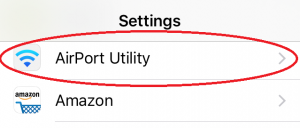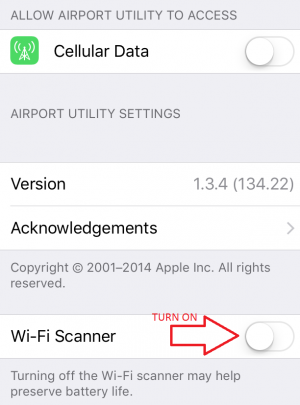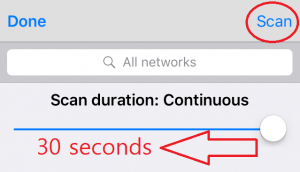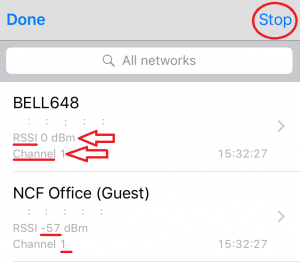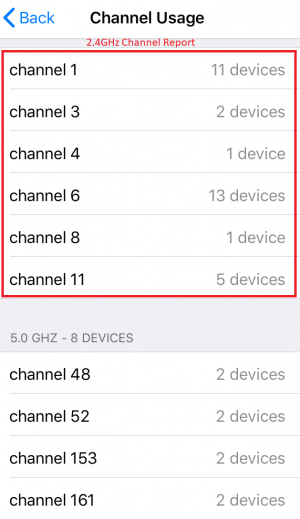Difference between revisions of "WiFi Analyzer for iOS"
m (→See Also) |
m |
||
| (8 intermediate revisions by the same user not shown) | |||
| Line 8: | Line 8: | ||
2. Go to iOS '''Settings''' and find scroll down until you find the '''AirPort Utility'''. | 2. Go to iOS '''Settings''' and find scroll down until you find the '''AirPort Utility'''. | ||
[[File:AirPortUtility1.png|alt=AirPortUtility - In IOS Settings|none|thumb|AirPortUtility - In IOS Settings]] | [[File:AirPortUtility1.png|alt=AirPortUtility - In IOS Settings|none|thumb|Fig 1. AirPortUtility - In IOS Settings]] | ||
3. Turn '''WiFi Scanner''' on. | 3. Turn '''WiFi Scanner''' on. | ||
[[File:AirportUtility2.png|alt=Airport Utility - Turning On Wi-Fi Scanner|none|thumb|Airport Utility - Turning On Wi-Fi Scanner]] | [[File:AirportUtility2.png|alt=Airport Utility - Turning On Wi-Fi Scanner|none|thumb|Fig 2. Airport Utility - Turning On Wi-Fi Scanner]] | ||
4. Open '''AirPort Utility''' and tap '''Wi-Fi Scan'''. | 4. Open '''AirPort Utility''' and tap '''Wi-Fi Scan'''. | ||
[[File:AirportUtility3.png|alt=Airport Utility - WiFi Scan|none|thumb|Airport Utility - WiFi Scan]] | [[File:AirportUtility3.png|alt=Airport Utility - WiFi Scan|none|thumb|Fig 3. Airport Utility - WiFi Scan]] | ||
5. | 5. Change the '''Scan Duration''' from '''Continuous''' to '''30 seconds''' by moving the Slider. Then tap '''Scan''' and wait 30 seconds. | ||
[[File:AirUtility4.png|alt=Airport Utility - Scan Start|none|thumb|Airport Utility - Scan Start]] | [[File:AirUtility4.png|alt=Airport Utility - Scan Start|none|thumb|Fig 4. Airport Utility - Scan Start]] | ||
6. Now you can see all the networks with their channels and RSSI levels. ''' | 6. You will know the scan is completed when the '''Stop''' option in the top right corner changes back to '''Scan'''. Now you can see all the networks with their channels and RSSI levels. If the '''Scan''' doesn't stop after 30 seconds click '''Stop.''' | ||
[[File:AirportUtility5.png|alt=Airport Utility - Scan Results|none|thumb|Airport Utility - Scan Results]] | [[File:AirportUtility5.png|alt=Airport Utility - Scan Results|none|thumb|Fig 5. Airport Utility - Scan Results]] | ||
7. Click on the info icon in the bottom right corner of the results page. | 7. The page will display a list of the WiFi networks around you, their RSSI and Channels. The RSSI represents the signal strength of the networks around you. Click on the info icon in the bottom right corner of the results page. | ||
[[File:AirportUtility7.png|alt=AirportUtility - Channel Reports Icon|none|thumb|Airport Utility - Channel Reports Icon]] | [[File:AirportUtility7.png|alt=AirportUtility - Channel Reports Icon|none|thumb|Fig 6. Airport Utility - Channel Reports Icon]] | ||
8. | 8. Find your '''best 2.4GHz channels'''. How to Interpret the Reports (using Fig 6 and 7): | ||
* Channels to avoid: | |||
** Avoid the high device count channels and those right next to them. In Fig 7 below, the high device count channels are '''1, 6''' and '''11'''. The channels right next to those are '''2, 5, 7''' and '''10''' | |||
** The channels of the top 5 WiFi networks besides your own. In Fig 6 above, the channels of the highest RSSI networks listed are Channels '''6''' and '''11'''. | |||
*** The remaining channels with few devices on them are '''3, 4 and 8''' | |||
* Take note of 2.4GHz channels (1 through 11) that are not listed and have not been ruled out already. In Fig 7 the unlisted channels are '''2, 5, 7''' and '''9''' but we rule out 2, 5 and 7 for being too close to the busiest channels. | |||
** Updated list of '''best 2.4GHz channels''': '''3, 4, 8 and 9''' | |||
[[File:AirportUtility6.png|alt=AirportUtility - Channel Summary|none|thumb|Fig 7. Airport Utility - Channel Summary]]9. For help interpreting the results, take a screenshot by using the key combination '''Power+Home''' and send the pictures to [mailto:support@ncf.ca support@ncf.ca] or in response to the most recent ticket email you have received from the NCF Help Desk. | |||
10. '''REMEMBER:''' go back into the '''Settings''' and turn off the '''WiFi-Scanner''' to conserve your device's battery. | |||
{{Template:WiFi_Analyzer_See_Also}} | |||
Latest revision as of 10:26, 1 May 2019
WiFi Analyzers: Windows | Windows 10 | Android | iOS | MacOS | Linux
How to Install and Check for WiFi Interference at Your Premises and Produce a Report for NCF
1. Download the AirPort Utility from the Appstore.
2. Go to iOS Settings and find scroll down until you find the AirPort Utility.
3. Turn WiFi Scanner on.
4. Open AirPort Utility and tap Wi-Fi Scan.
5. Change the Scan Duration from Continuous to 30 seconds by moving the Slider. Then tap Scan and wait 30 seconds.
6. You will know the scan is completed when the Stop option in the top right corner changes back to Scan. Now you can see all the networks with their channels and RSSI levels. If the Scan doesn't stop after 30 seconds click Stop.
7. The page will display a list of the WiFi networks around you, their RSSI and Channels. The RSSI represents the signal strength of the networks around you. Click on the info icon in the bottom right corner of the results page.
8. Find your best 2.4GHz channels. How to Interpret the Reports (using Fig 6 and 7):
- Channels to avoid:
- Avoid the high device count channels and those right next to them. In Fig 7 below, the high device count channels are 1, 6 and 11. The channels right next to those are 2, 5, 7 and 10
- The channels of the top 5 WiFi networks besides your own. In Fig 6 above, the channels of the highest RSSI networks listed are Channels 6 and 11.
- The remaining channels with few devices on them are 3, 4 and 8
- Take note of 2.4GHz channels (1 through 11) that are not listed and have not been ruled out already. In Fig 7 the unlisted channels are 2, 5, 7 and 9 but we rule out 2, 5 and 7 for being too close to the busiest channels.
- Updated list of best 2.4GHz channels: 3, 4, 8 and 9
9. For help interpreting the results, take a screenshot by using the key combination Power+Home and send the pictures to support@ncf.ca or in response to the most recent ticket email you have received from the NCF Help Desk.
10. REMEMBER: go back into the Settings and turn off the WiFi-Scanner to conserve your device's battery.

